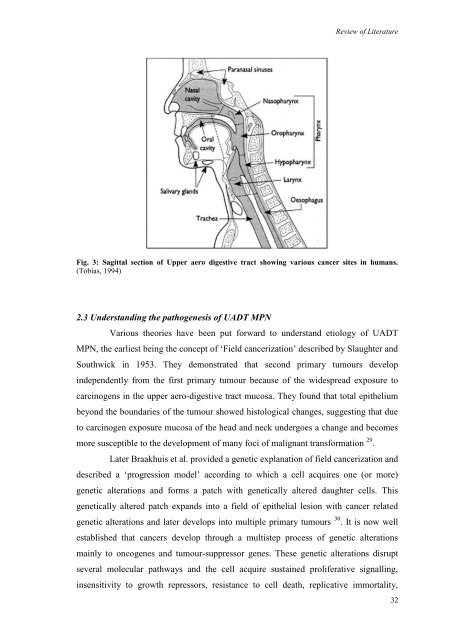LIFE09200604007 Tabish - Homi Bhabha National Institute
LIFE09200604007 Tabish - Homi Bhabha National Institute
LIFE09200604007 Tabish - Homi Bhabha National Institute
You also want an ePaper? Increase the reach of your titles
YUMPU automatically turns print PDFs into web optimized ePapers that Google loves.
Review of Literature<br />
Fig. 3: Sagittal section of Upper aero digestive tract showing various cancer sites in humans.<br />
(Tobias, 1994)<br />
2.3 Understanding the pathogenesis of UADT MPN<br />
Various theories have been put forward to understand etiology of UADT<br />
MPN, the earliest being the concept of „Field cancerization‟ described by Slaughter and<br />
Southwick in 1953. They demonstrated that second primary tumours develop<br />
independently from the first primary tumour because of the widespread exposure to<br />
carcinogens in the upper aero-digestive tract mucosa. They found that total epithelium<br />
beyond the boundaries of the tumour showed histological changes, suggesting that due<br />
to carcinogen exposure mucosa of the head and neck undergoes a change and becomes<br />
more susceptible to the development of many foci of malignant transformation 29 .<br />
Later Braakhuis et al. provided a genetic explanation of field cancerization and<br />
described a „progression model‟ according to which a cell acquires one (or more)<br />
genetic alterations and forms a patch with genetically altered daughter cells. This<br />
genetically altered patch expands into a field of epithelial lesion with cancer related<br />
genetic alterations and later develops into multiple primary tumours 30 . It is now well<br />
established that cancers develop through a multistep process of genetic alterations<br />
mainly to oncogenes and tumour-suppressor genes. These genetic alterations disrupt<br />
several molecular pathways and the cell acquire sustained proliferative signalling,<br />
insensitivity to growth repressors, resistance to cell death, replicative immortality,<br />
32

















